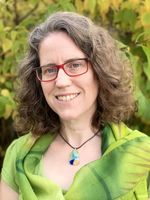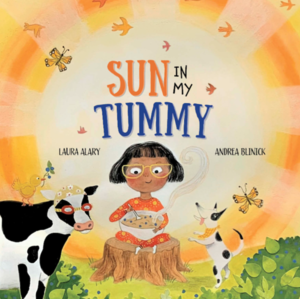"Our World is an Amazing Place" Laura Alary on Her New Kids' Book Exploring Photosynthesis, Food, & Connection
It's easy to forget how fascinating the idea that plants can "eat" sunlight and use it to grow and thrive actually is, but in Laura Alary's Sun in My Tummy (Pajama Press, with artwork by Andrea Blinick) when one little girl's mother decides to use breakfast time to explain to her daughter about the journey from seed to plant—and how plants get energy from the sun just like we do from food—it's a reminder of how intricate, interesting, and just plain cool the natural world really is.
Gentle and engaging, Sun in my Tummy shows young readers how oats, blueberries, grass, and more burst into life. A sweet introduction to STEM ideas, and written in easy to follow free verse, the book is also a great way to talk about food, bodies, and cooking. Alary even includes an accessibly written author's note to further explain the process of photosynthesis for extra curious readers. With starred reviews in School Library Journal and Quill & Quire, it's clear this is a special book that will engage keen kids right on their level.
Laura joins us today to talk about Sun in My Tummy, her writing process, and more, telling us about a beautiful quote by activist and Vietnamese monk Thích Nhất Hạnh that inspired the book's point of view, her favourite moments in the long journey of creating a new book, and how, if you get creative, there can be "many doors" into an interest in science for kids.
Open Book:
Tell us about your new book and how it came to be.
Laura Alary:
Sun in My Tummy begins with a little girl struggling (as many of us do) to leave the warmth of her bed and get up in the dark. But the voice of the narrator (her mother) tells her it is time to put the sun in her tummy. The rest of the book explores what that means. In addition to being a poetic introduction to photosynthesis, Sun in My Tummy takes shows how all living things are connected to one another and to the sun.
The seed for the book was a question posed by a student at a school where I was working. As we were all having lunch together one day he asked me where our food came from. That prompted us to look at each thing on our plates and try to figure out everything that went into making it—not just the ingredients but elements of nature like rain and sunshine.
A few months later I came across these beautiful words by Thich Nhat Hahn: In this plate of food I see the whole universe supporting my existence. I was so moved by that level of awareness and perception I wanted to share it with children in a way they could comprehend. I guess you could say Sun in My Tummy is a STEM book with mindfulness and gratitude and poetry swirled through it.
OB:
Is there a message you hope kids might take away from reading your book?
LA:
The core message is this: our world is an amazing place and you are part of it. The more carefully you look, the more clearly you can see that everything is connected. So we need to treat each thing with care and respect.
OB:
What do you need in order to write – in terms of space, food, rituals, writing instruments?
Your CanLit News
Subscribe to Open Book’s newsletter to get local book events, literary content, writing tips, and more in your inbox
LA:
I need different things at different stages of the writing process. When I am first playing with an idea I do a lot of brainstorming while walking. So a good pair of running shoes is essential! I always carry a pen and a little notebook to jot down words or phrases that come to me out of the blue. Those notebooks are like junk drawers in the kitchen; full of jumbled bits and pieces that might be useful sometime. I have also been known to scribble on envelopes, serviettes, bookmarks—or even my own arm!
When I get to the stage of outlining and writing the story, I need a good pen and a blank book. I have never been able to write on a computer. There is something about the physical connection with paper and ink and the movement of my hand that helps with the creative flow. A few years ago a friend gave me a beautiful fountain pen. I use it to write longhand, usually in purple ink, which makes me feel like I am creating something special. The environment has to be quiet—no background music or people chatting. Natural light helps, so when I can I write outdoors. Someday I would love to have a writing space with a huge window.
OB:
Do you feel like there are any misconceptions about writing for young people? What do you wish people knew about what you do?
LA:
People often assume picture books are easy to write because they are short. The truth is, having to work with so few words means you need to be very precise about which words you choose. There is an art to saying important things simply and distilling big ideas to what is most essential. It is definitely not easy.
Whenever I hear someone complain about how much a picture book costs I wish they understood how much thought and care and effort goes into it—not just the work of the author, but the illustrator, the editor, and the whole design team. Buying a beautiful book for a child is an investment in art.
OB:
What defines a great book for young readers, in your opinion? Tell us about one or two books you consider to be truly great kids books, whether you read them as a child or an adult.
LA:
I think the best books for kids are both simple and truthful. When readers can really recognize themselves and their own feelings and experiences, that is a great book. The best books don’t shy away from hard things. There is a spread in Love by Matt de la Peña that shows a child hiding under the piano with his head down and his arms wrapped around his knees, while in the foreground a woman is crying with her hands over her face and a man is stalking out of the room. The words are, “But it’s not only stars that flame out, you discover. It’s summers too. And friendships. And people.” That is such a tough moment to include in a picture book, but it’s true, and having it there allows the rest of the book to shine without seeming false or sentimental.
One of my favourite picture books is Last Stop on Market Street, also by Matt de la Peña. I love how something as ordinary as a bus ride becomes an adventure, how the little boy observes the people around him with such freshness, and how his grandmother stretches his thinking and seeing even further. I love the gentle humour, the suspense of not knowing where they are going, and the surprise twist at the end. There is no pity or false sentiment in the book, just real kindness.
Another thing that makes a book great is when it combines depth with humour. In my opinion, nobody does this better than Arnold Lobel in the Frog and Toad books (except perhaps James Marshall in the George and Martha series). Those books literally make me laugh out loud because I can see myself and people I know reflected in them so clearly. But their tone is always affectionate and sympathetic even as they are poking fun. Toad is really cranky sometimes, and Martha can be vain and prickly, but I find them both completely endearing. There is something powerful about being able to write books that help us see ourselves and others honestly but with understanding and compassion.
OB:
What's your favourite part of the life cycle of a book? The inspiration, writing the first draft, revision, the editorial relationship, promotion and discussing the book, or something else altogether? What's the toughest part?
LA:
I enjoy pretty much every stage. I love the rush I get early on when I am playing with an idea and suddenly a phrase or a concept pops into my head out of the nowhere. If this happens while I am out for a walk I have to chant the phrase over and over to help me remember until I can find a piece of paper and write it down. My neighbours probably think I am a bit odd.
I also love working with an editor on the nitty-gritty of polishing a manuscript. Being a perfectionist can be a problem in many aspects of life but when I am trying to refine a manuscript my persnickety side comes in handy. It takes a lot of precision to craft a good picture book and I find the process satisfying.
Another favourite moment is when I get my first glimpse of the art and I can see what new and surprising things the illustrator has brought to the story. It is such a privilege and a pleasure to see how an artist interprets and enlarges my words.
OB:
What are you working on now?
LA:
I have been working on more narrative nonfiction, along the lines of Sun in My Tummy, but looking at different aspects of the natural world. Science fascinates me, but I have never been very good at math, so writing picture about science and the scientists is my way of being part of that world.
Not long ago I read an interview with a popular science writer who compared science to a castle with many entrances. Sometimes we think there is only one way in—through math—so if you struggle with the language of numbers there is no hope of getting access. But there are many doors. Science starts with curiosity and wonder about the world and how it works. Writing about these things is my doorway into the castle. I hope I can bring a lot of children along with me.
[Editor's note: Laura also has a busy season coming up with the release of The Astronomer Who Questioned Everything: The Story of Maria Mitchell this week from Kids Can Press and Here: The Dot We Call Home in September from Paraclete Press. Congratulations, Laura!]
_____________________________________________________
Laura Alary believes in writing stories that make us bigger on the inside. Born in Halifax, she earned her B.A. with Honours in classics at Dalhousie University before moving to her current home of Toronto, where she completed a Ph.D. at University of St. Michael’s College. Laura has worked as a lecturer, a library assistant, and a music specialist in Montessori classrooms, all the while writing books and raising her three children. Laura’s most recent title is What Grew in Larry’s Garden, which won the IODE Jean Throop Book Award in 2021.






